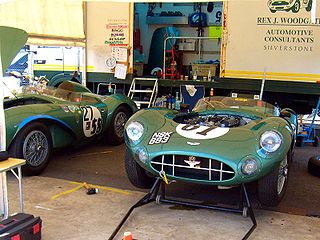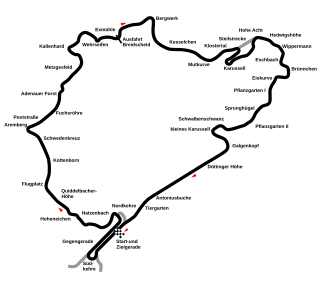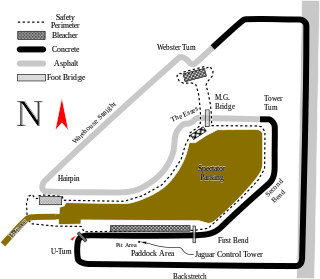
The 1961 Formula One season was the 15th season of Formula One motor racing. It featured the 1961 World Championship of Drivers and the 1961 International Cup for F1 Manufacturers, which were contested concurrently from 14 May to 8 October over an eight race series. The season also included numerous non-championship races for Formula One cars.

Roy Francesco Salvadori was a British racing driver and team manager. He was born in Dovercourt, Essex, to parents of Italian descent. He graduated to Formula One by 1952 and competed regularly until 1962 for a succession of teams including Cooper, Vanwall, BRM, Aston Martin and Connaught. Also a competitor in other formulae, he won the 1959 24 Hours of Le Mans in an Aston Martin with co-driver Carroll Shelby.

The 1961 24 Hours of Le Mans was a motor race for Sports cars and Grand Touring cars staged at the Circuit de la Sarthe, Le Mans, France on 10 and 11 June 1961. It was the 29th Grand Prix of Endurance and the fourth race of the 1961 World Sportscar Championship. Ferrari and Maserati were the main contenders, with Aston Martin an outside chance.

The 1960 24 Hours of Le Mans was the 28th 24 Hours of Le Mans Grand Prix of Endurance, and took place on 25 and 26 June 1960, on Circuit de la Sarthe. It was the fifth and final round of the F.I.A. World Sports Car Championship as well as being the fifth round of the inaugural FIA GT Cup. It was held just a week after the tragic Belgian F1 GP in which two drivers were killed and Stirling Moss and another driver were seriously injured. The prospect of a duel between the 3-litre (180 cu in) Ferrari versus the 2-litre (120 cu in) Porsche championship-leaders was enough to draw large crowds to the 24 Hours race and some 200,000 spectators had gathered for Europe's classic sports car race, around the 13.5 km (8.4 mi) course.

The 1959 24 Hours of Le Mans was the 27th 24 Hours of Le Mans, Grand Prix of Endurance, and took place on 20 and 21 June 1959, on Circuit de la Sarthe. It was also the fourth round of the F.I.A. World Sports Car Championship. The prospect of an exciting duel between Ferrari, Aston Martin and giantkillers Porsche was enough to draw large crowds and some 150,000 spectators gathered for France's classic sports car race, around the 8.38-mile course.
The 1957 World Sportscar Championship season was the fifth season of the FIA World Sportscar Championship. It was a series for sportscars that ran in many worldwide endurance events. It ran from 20 January 1957 to 3 November 1957, and comprised seven races.
The 1959 World Sportscar Championship was the seventh FIA World Sportscar Championship. It was a series for sportscars that ran in many worldwide endurance events. It ran from 21 March 1959 to 5 September 1959, and comprised five races, following the 1000 km Buenos Aires being removed from the calendar, although the race did return in 1960.

The Aston Martin DBR1 is a sports racing car built by Aston Martin starting in 1956, intended for the World Sportscar Championship as well as non-championship sportscar races at the time. It is most famous as the victor of the 1959 24 Hours of Le Mans, Aston Martin's only outright victory at the endurance classic. It is one of only three cars in the 1950s to win both the World Sports Car Championship and Le Mans 24 Hours in the same year. In addition the six World Sports Car Championship victories was a record for any car in the 1950s and remained a record in the championship until surpassed by the Ferrari 250TR. The three consecutive triumphs in 1959 at the Nürburgring, Le Mans and the Tourist Trophy equalled the record set by the Ferrari 250TR with its three consecutive victories at the start of the 1958 season.

The 1955 RAC Tourist Trophy took place on 17 September, on the roads around Dundrod,. It was also the fifth round of the F.I.A. World Sports Car Championship, however it was the first championship race following the horrendous tragedy at Le Mans. It was also the Golden Jubilee year for the RAC Tourist Trophy. Going into the race, Ferrari were leading the Manufacturers Championship by four points from Jaguar. Victory for the Italian marque would put them in a strong position to win a third successive title.

The 3. Internationales ADAC 1000 Kilometer Rennen auf dem Nürburgring took place on 26 May 1957, on the Nürburgring Nordschleife,. It was also the fourth round of the F.I.A. World Sports Car Championship. This would the first championship since the dreadful events in the Mille Miglia, Italy just a fortnight ago, where Alfonso de Portago crashed killing himself, his co-driver and nine spectators.

The 1958 12-Hour Florida International Grand Prix of Endurance for the Amoco Trophy took place on 22 March, on the Sebring International Raceway,. It was the second round of the F.I.A. World Sports Car Championship, which was running to new regulations introduced at the beginning of the season. The most influential of these regulations changes would be the 3.0 litre engine size limit. This was seventh running of the 12-hour race.
The 42° Targa Florio took place on 11 May, on the Circuito Piccolo delle Madonie,. It was the third round of the 1958 World Sportscar Championship, which was running to new regulations introduced at the beginning of the season. The most influential of these regulations changes would be the 3.0 litre engine size limit. The event returned to the championship for the first time since 1955, following the demise of the Mille Miglia and the ban on road racing on mainland Italy. But such outcry did not deter Vincenzo Florio from holding his event on the traditional 45 mile mountainous circuit.

The 4. Internationales ADAC 1000 Kilometer Rennen Nürburgring took place on 1 June, on the Nürburgring Nordschleife,. It was also the fourth round of the F.I.A. World Sports Car Championship, which was running to new regulations introduced at the beginning of the season.

The 1958 RAC Tourist Trophy took place on 13 September on the Goodwood Circuit (England). It was also the sixth and final round of the F.I.A. World Sports Car Championship. This was the first time the RAC Tourist Trophy had taken place since 1955, following the death of three drivers during the race that year.

The 1959 12-Hour Florida International Grand Prix of Endurance for the Amoco Trophy was a motor race for sportscars, staged on 21 March at the Sebring International Raceway, Florida, United States. It was the opening round of the 1959 World Sportscar Championship and was the eighth running of the 12 Hours of Sebring.

The ADAC 1000 Kilometer Rennen took place on 7 June, on the Nürburgring Nordschleife,. It was also the third round of the F.I.A. World Sports Car Championship.

The Tenth Annual Sebring International Grand Prix of Endurance for the Amoco Trophy took place on 26 March 1960, on the Sebring International Raceway,. It was the second round of the F.I.A. World Sports Car Championship. This was also the second round of the F.I.A. GT Cup.

The VI. Internationales ADAC 1000 Kilometer Rennen took place on 22 May, on the Nürburgring Nordschleife,. It was the fourth round of the F.I.A. World Sports Car Championship. This was also the third round of the FIA GT Cup.
Peter James Scott Lumsden, CBE was a British motorsport competitor who gained renown between 1959 and 1965 racing at Le Mans, the Nürburgring, Silverstone & Goodwood before twice winning at Brands Hatch in his final season in 1965. He is the younger son of Lieutenant-General Herbert Lumsden and brother of Michael.
The 1960 Formula Two season was the last season of 1.5 litre Formula Two racing which was to become Formula One for 1961. Two championships were held over the same five events, the Formula Two Constructors' Championship and the Formula Two Drivers' Championship, in addition to many non-championship Formula Two events. The Constructors' Championship was won in a draw by Cooper-Climax and Porsche, while the Drivers' Championship was won by Jack Brabham.








